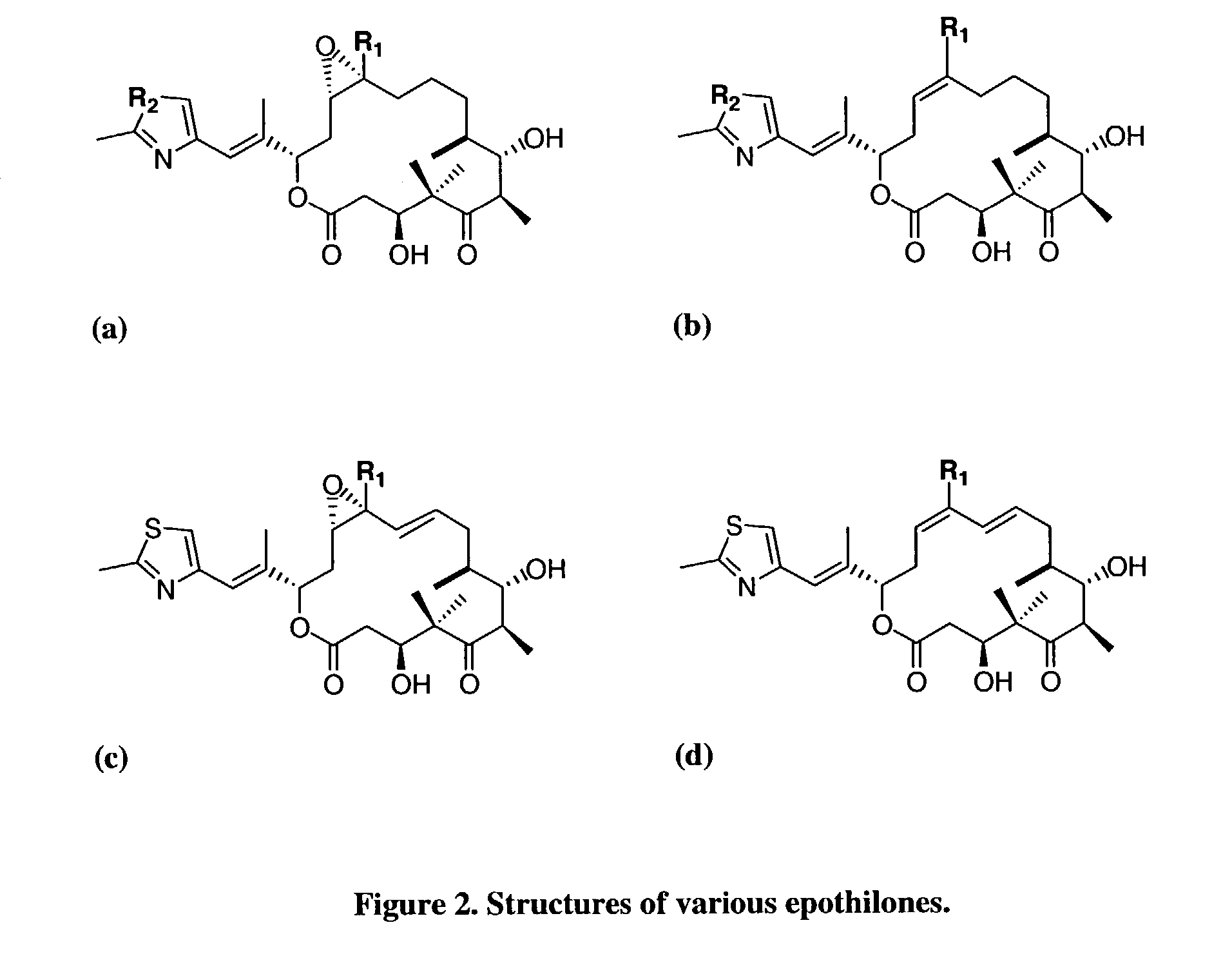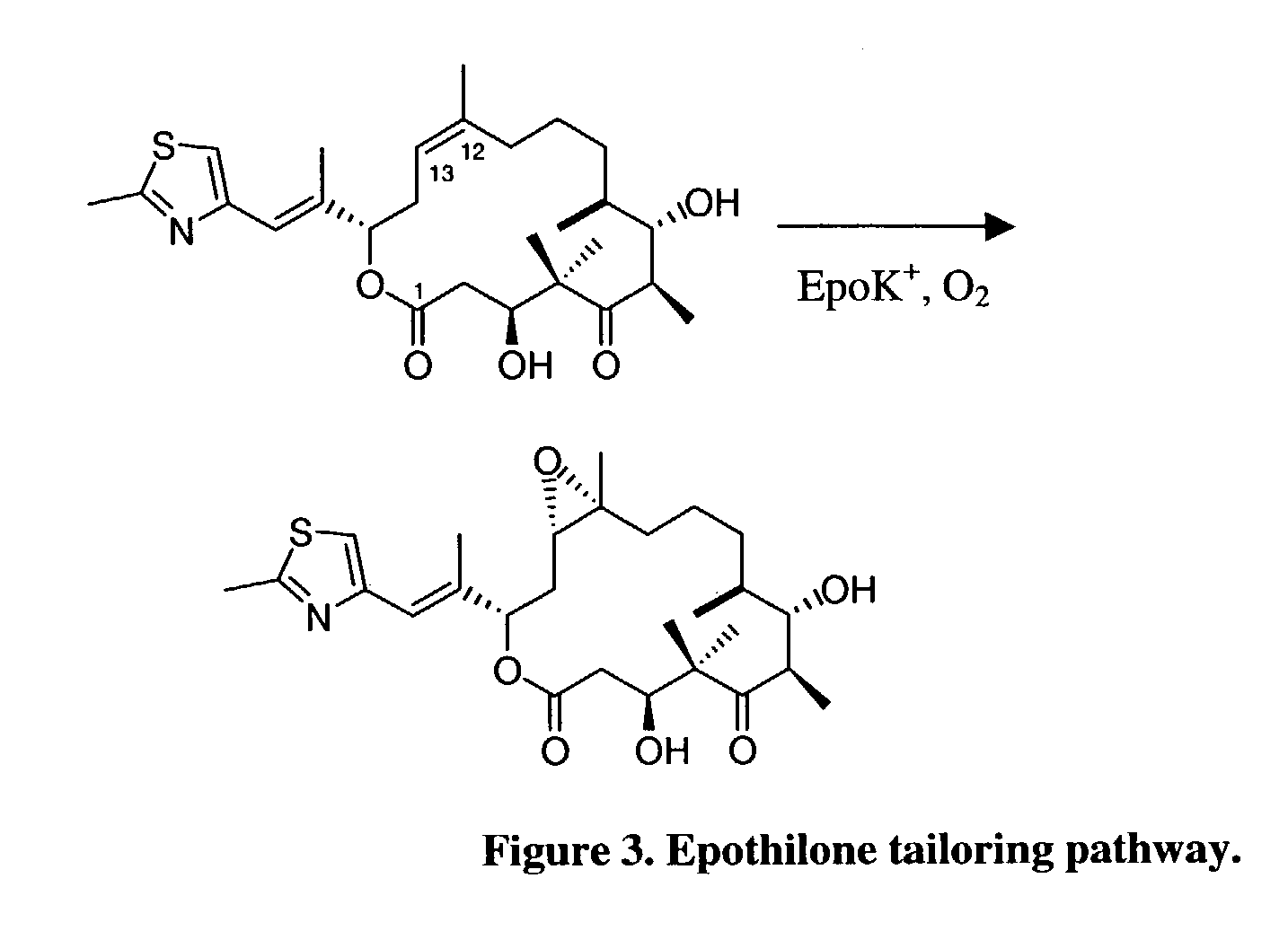Secondary metabolite congener distribution modulation
a distribution modulation and second-metabolite technology, applied in the field of recombinant methods and materials for producing polyketides, can solve the problems of difficult or impossible engineering, poor substrate of erythromycin b, etc., and achieve the effect of higher ratio of epothilone d
- Summary
- Abstract
- Description
- Claims
- Application Information
AI Technical Summary
Benefits of technology
Problems solved by technology
Method used
Image
Examples
example 1
Cultivation of Host Cells Under Modulated Oxygen Tension Conditions
[0080]Bacterial Strains. The epothilone polyketide synthase was cloned from Sorangium cellulosum SMP44, and introduced into Myxococcus xanthus strain DZ1 (Julien et al., in press). The M. xanthus epothilone B producer (K111-32.25) has a functional EpoK epoxidase (EpoK+), while this enzyme has been genetically inactivated (EpoK−) in the epothilone D producing strain (K111-40.1). The activity of the enoyl reductase (ER5) domain of the epothilone PKS was eliminated by introduction of a point mutation in both the K111-32.25 and K111-40.1 strains to produce strains K165-79.7 and K165-76.2, respectively. Strains K165-79.7 and K165-76.2 were engineered to produce 10,11-didehydro-epothilones B and D (FIG. 2), respectively.
[0081]Bioreactor Inoculum Expansion. All media components were obtained from Sigma (St. Louis, Mo.), unless otherwise specified. All M. xanthus cultures were initiated by reviving a 1 mL frozen cell bank vi...
example 2
Production of Novel Epothilones
[0086]The epothilone PKS has been genetically altered to create strains of the present invention which produce novel epothilones which potentially may exhibit increased water solubility and / or potency against tumor cell lines. The oxygenation control method of the present invention was applied to an engineered Myxococcus xanthus production strain (strain K165-79.7, EpoK+) which had been genetically engineered to produce a novel epothilone, 10,11-didehydro-epothilone B (FIG. 2). When its counterpart, strain K165-76.2 (EpoK−), was cultivated under an excess oxygenation condition, 10,11-didehydro-epothilones C and D (FIG. 2) were found to be the sole products. The active EpoK enzyme in strain K165-79.7 was expected to catalyze epoxidation of this 10,11-didehydro-epothilone D intermediate into 10,11-didehydro-epothilone B (FIG. 6a) in the presence of excess oxygen. However, this compound was not detected; instead, a novel isomer (Epo506) was the primary pr...
example 3
Modulated Epothilone Congener Production in Sorangium cellulosum strain Soce90 K111-150.17
[0091]Modulation of dissolved oxygen during cultivation of heterologous host cells has been shown to shift polyketide congener distribution. In this example, an epothilone producing strain was subjected to oxygen tension resulting in shifting of epothilone congener distribution when cultivated under oxygen depletion conditions. Sorengium cellulosum strain Soce90 K111-150.17 (ATCC deposit designation PTA-5093 is a rifamycin-resistant mutant derived from Soce90 parent strain through UV mutagenesis (B. Julien, unpublished results). The cultivation methodologies and analytical methods used in this example were as done as described in Example 1 above.
[0092]Sorangium cellulosum strain Soce90 K111-150.17 is an epothilone A and B producer that has an active epoK gene. FIG. 8 (a) illustrates the cell growth over time measured by optical density (OD) at 600 nm in three different dissolved oxygen (DO) con...
PUM
| Property | Measurement | Unit |
|---|---|---|
| concentrations | aaaaa | aaaaa |
| saturation concentration | aaaaa | aaaaa |
| oxygen tension | aaaaa | aaaaa |
Abstract
Description
Claims
Application Information
 Login to View More
Login to View More - R&D
- Intellectual Property
- Life Sciences
- Materials
- Tech Scout
- Unparalleled Data Quality
- Higher Quality Content
- 60% Fewer Hallucinations
Browse by: Latest US Patents, China's latest patents, Technical Efficacy Thesaurus, Application Domain, Technology Topic, Popular Technical Reports.
© 2025 PatSnap. All rights reserved.Legal|Privacy policy|Modern Slavery Act Transparency Statement|Sitemap|About US| Contact US: help@patsnap.com



